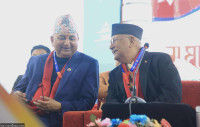Opinion
Converging faiths
Halesi temple needs an inclusive body consisting of people of different ethnicities and faiths
Hari Shrestha
Last month, a research grant provided by the Saarc Cultural Centre led us to a far away village in the Eastern hills of Nepal, popularly known as Halesi, located in Khotang district. The field visit was aimed at learning the significance of the Halesi Mahadev, which is a religious centre and draws a large number people from different ethno-cultural backgrounds. Halesi is considered an abode of deities of three major religious faiths—Hinduism, Buddhism and Kirat dharma—along with several local cults and traditions.
The field trip offered a good opportunity to witness a very interesting scenario at the cave shrine of the Halesi Mahadev. Buddhist Lamas were chanting their mantras and performing Buddhist rituals at one corner of the complex while in another corner, there were people taking part in Hindu Brahmanic rituals as it was Balachaturdasi (sadbiuchharne parva), a Hindu festival where people sprinkle grains in the name of the dead. People of various ethno-cultural backgrounds, from native Kirat Rais to Tharus from the Tarai plains, Buddhist people both from home and abroad and some foreigners from Singapore and Europe were all participating and celebrating the festival at Halesi.
Where religions meet
How did Halesi develop as a focal point for many religions in Nepal? A group discussion was initiated with this question which revealed many new interpretations about the origins of Halesi. One argued that the term 'Halesi' was coined after the name of Holesung, a Kirat king who ruled over the region during the medieval period. Buddhist traditions claim that the origins of the name is related to an event where a Tibetan Buddhist visited the place and said holyasso, a Tibetan word meaning a place of wonders. A commonly held Hindu legend suggests that Lord Shiva came to Halesi to hide from a monster, Vrsasur, who wanted to kill him. Vishnu tricked the monster and killed him as Shiva broke through the ceiling of the cave and fled . Since then, Halesi has been deemed a holy place and associated with the Mahadev. In the absence of authentic documents, such oral histories could be understood as a clever way to promote one's religion by people with different religious backgrounds. Yet, sometimes, they do highlight certain events and contain a grain of truth.
For Hindus, Halesi is a sacred place depicted by the presence of the Mahadev in the form of a linga, the phallus, and symbolic stone images of Parvati and the vasaha, the carrier of Shiva. According to Buddhists, Padmasambhav, a Buddhist guru who lived in the 7th century, in the course of his journey towards Tibet, came to Halesi and meditated inside a cave, gaining the power to live long from amitayusa by defeating the mara, the demonic forces that caused trouble during his meditation. Since then, the cave became popularly known as Halesi-Maratika among the Tibetan-Buddhist community. The Kirats, as ardent followers of the Kiratesvara Mahadeva, have been closely associated with the Halesi shrine as natives of the place. They moved to the Eastern hills of Nepal after the downfall of their regime in Kathmandu in the beginning of the Common Era. The Kirati oral tradition suggests that Bagbansi Rai, a local from Halesi, discovered the cave in the ancient past. Gradually, hypothetical images and the amazing structure of the cave caught the attention of people far and wide. The Hindu-Buddhist-Kirat myths further popularised the place and glorified it as a spiritual power centre for people of different philosophies and faiths.
Geologically speaking
From a geological perspective, two major caves of importance, situated in the central rocky, tree covered hillock of Halesi bazaar, represents a typical rock formation usually observed in areas consisting of limestone or carbonate rock. Acidic rain water contributed to the loosening of the calcareous part of the rock and resulted in many cavities, producing rock structures of various forms and shapes. There are many narrow passageways between two stalagmites inside the Halesi-Maratika cave formed through the natural process of geological transformation. These narrow passageways have now turned into pap dvaar, dharma dvaar, garbha dvaar and karma dvaar to judge the fate and purity of the pilgrims who want to pass through these passages. In many other parts of Nepal, such astonishing geological formations have been identified as mysterious signs from the divine and these places have obtained the status of spiritual power centres. This holds true for Halesi too.
Changes over time
Halesi has a history of about 2,000 years and has passed through many stages of development. From the time of Rana Bahadur Shah, the Kirats were replaced by the Mahanta Giris as priests in Halesi. For a long period of time, the Mahanta priestly tradition remained unchallenged. But some remarkable changes have taken place in the management and ritual practices of Halesi in the last few years. In line with the political changes in the country in recent times, many ethnic groups have raised their voices for cultural reorientation. As a result, the local Rais and people of other communities started seeking equal rights in the management of Halesi. Right now, there are two inclusive committees working for the management and development of the Halesi temple. The income of the temple is now handled by the temple management committee. Previously, those earnings were the private property of the pujaris. A local college also receives a certain share of the temple income. This is a good way to use the temple earnings for social service. The committee looks after the maintenance of the temple and manages annual celebration events.
There are some other genuine issues raised by local community in terms of introducing a master plan for the preservation of the temple and overall development of the entire Halesi village. The temple development committee should be reorganised, ensuring the representation of all religious groups concerned. The natural beauty of the cave shrine should also be restored. It currently remains threatened by land encroachment around the temple complex. The need of the hour is for the government to address the concerns of the local people. This will highlight the assimilative and integrative role Halesi has been playing for centuries.
Shrestha is Associate Professor of Culture and Archaeology at the Tribhuvan University




 8.12°C Kathmandu
8.12°C Kathmandu










